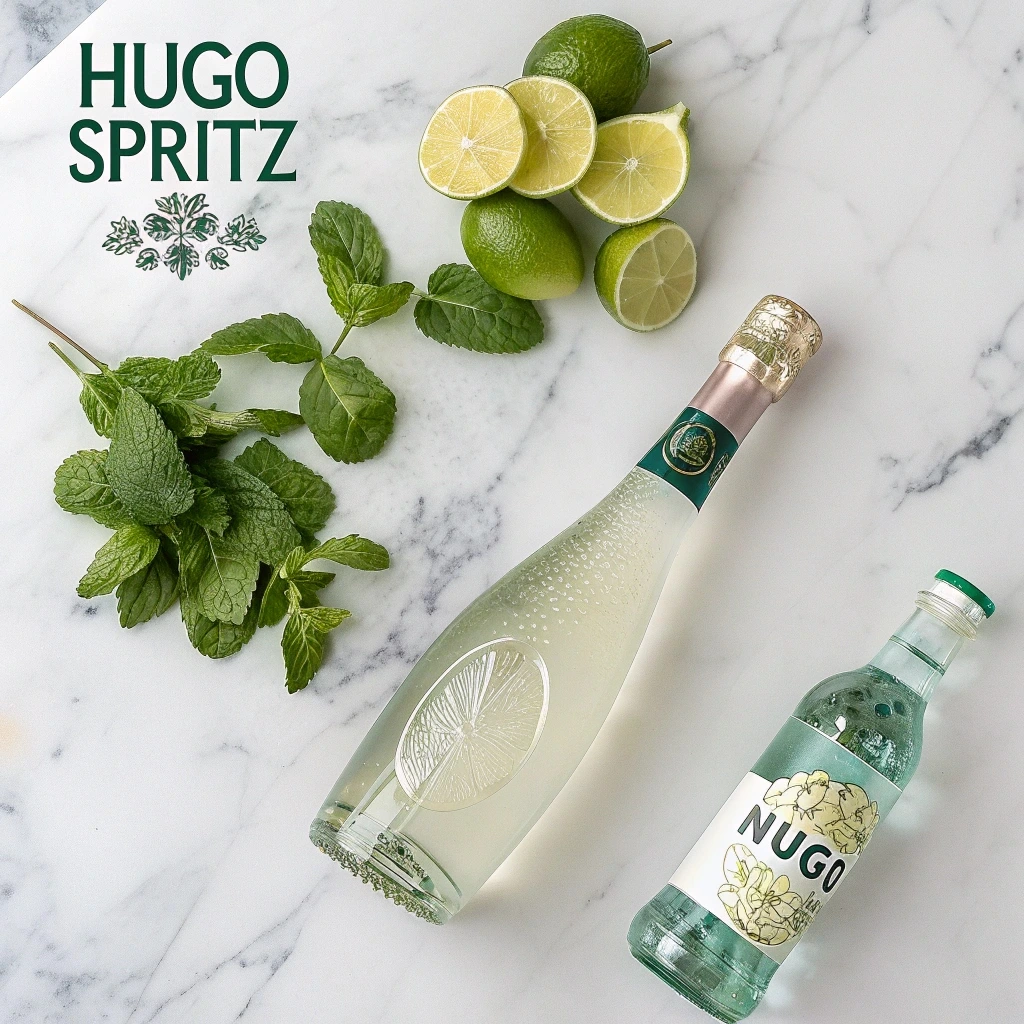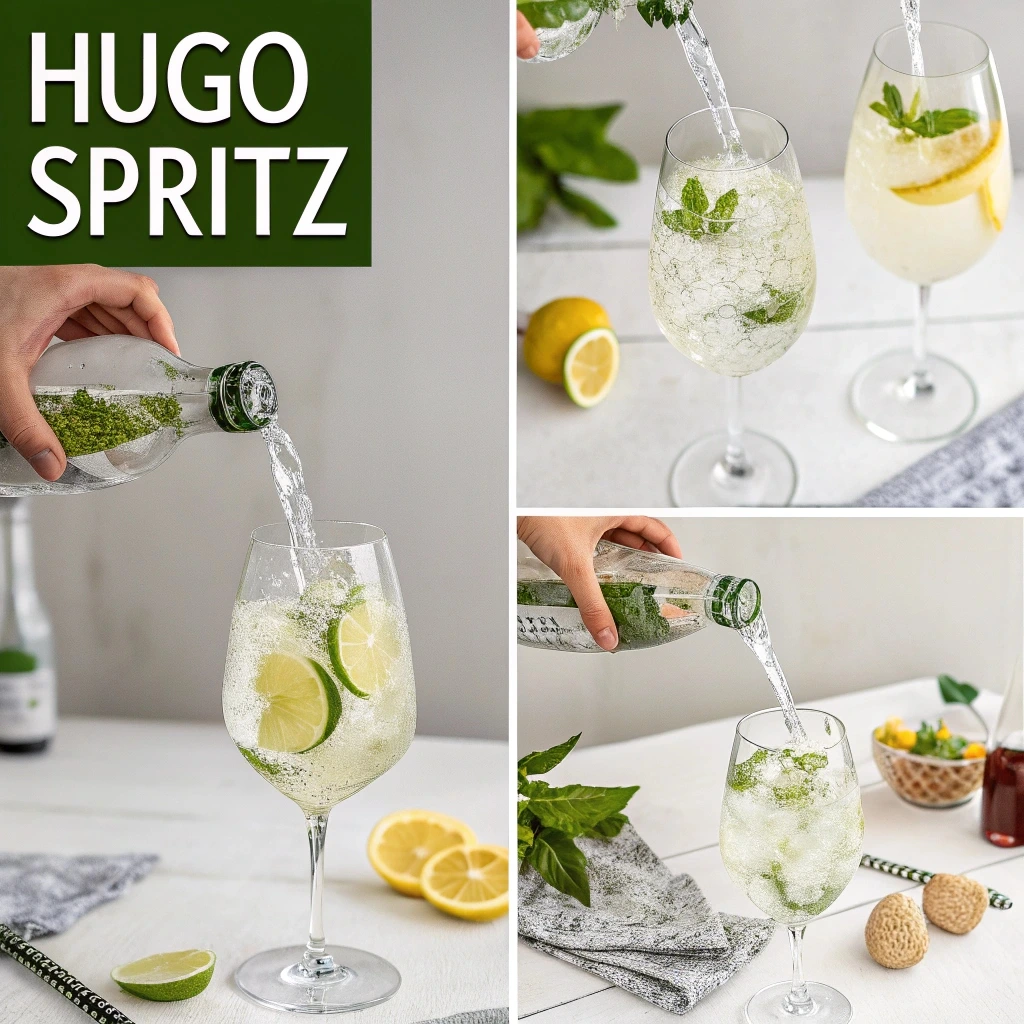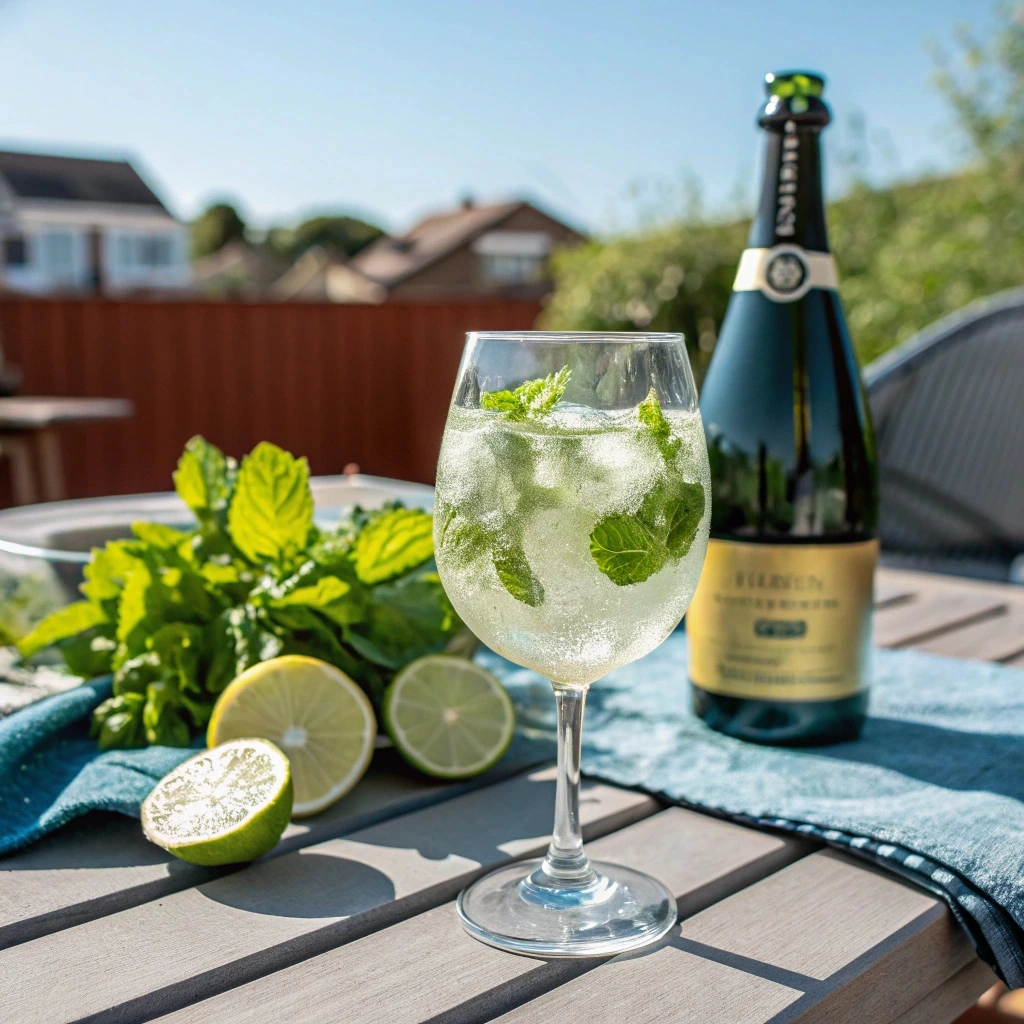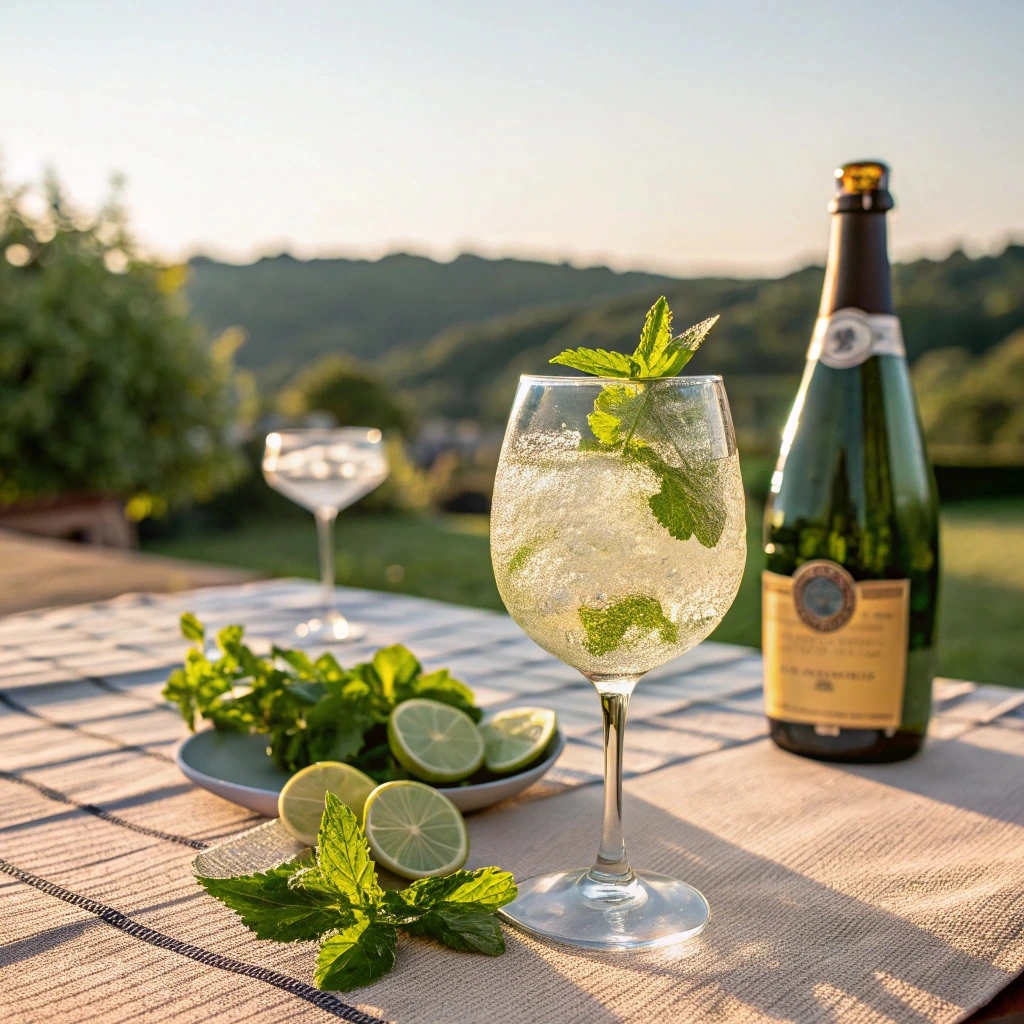Looking for a light, bubbly cocktail that tastes like summer in a glass? You’ve just found it. The Hugo Spritz recipe has quickly become a favorite across Europe and beyond, blending fresh mint, elderflower, and crisp sparkling wine into one delightful sip.
In this guide, we’re diving into everything you need to know—from its Italian roots to how to whip one up at home, even with a few twists. You’ll also discover tips for serving, pairing ideas, and expert insights to make sure your next spritz is nothing short of perfection.
So, whether you’re hosting a backyard gathering or simply cooling off after a hot day, this refreshing drink will have you sipping in style. Let’s start with what exactly a Hugo Spritz is and why it’s caught the world’s attention.
Table of Contents
What is a Hugo Spritz?
Introduction to the Hugo Spritz cocktail
The hugo spritz recipe is more than just a trendy drink—it’s an embodiment of la dolce vita. Born in northern Italy, this elderflower cocktail mixes together bubbly prosecco, fragrant elderflower syrup or liqueur, fizzy water, fresh mint, and a slice of lime. Light, floral, and oh-so-refreshing, it’s the ideal aperitivo for warm weather.
But here’s the thing—unlike heavier cocktails, the Hugo keeps it crisp and easy on the booze. That makes it perfect for daytime sipping, rooftop hangs, or even a relaxed brunch. Think of it as the chill cousin of the bold Aperol Spritz.
Moreover, its elegant simplicity makes it easy for anyone to prepare, no mixology degree needed.
Origins and cultural significance in Italy
The story of the Hugo Spritz recipe begins in 2005, in South Tyrol, a picturesque province nestled in the Italian Alps. A bartender named Roland Gruber decided to offer a lighter alternative to the iconic Aperol Spritz. Instead of bitter orange notes, he turned to floral elderflower syrup—originally lemon balm, but elderflower quickly took center stage thanks to its delicate, aromatic profile.
Since then, the drink has gained major traction across Europe, especially in Italy, Austria, and Germany. Today, you’ll find the hugo spritz recipe on café menus in Milan, beachside bars in Spain, and even upscale cocktail lounges in New York.
Therefore, it’s safe to say that this floral prosecco spritz has gone global. And honestly? It’s easy to see why. It’s quick to make, easy to love, and stunning to serve.
Ready to mix your own? Let’s take a look at the key ingredients that give this summer classic its signature charm.
Key Ingredients in a Hugo Spritz Recipe

Prosecco: Why Italian sparkling wine is essential
Prosecco is the bubbly backbone of the Hugo Spritz recipe. This Italian sparkling wine brings a crisp, fruity touch that balances beautifully with the floral notes of elderflower. It’s lighter and less expensive than Champagne, but just as festive. Therefore, it’s the perfect choice for a casual cocktail that still feels a bit fancy.
You don’t need to splurge—just choose a dry (Brut) or extra-dry variety with good effervescence. Moreover, keep your Prosecco chilled until the very last minute for that extra-refreshing sip.
Elderflower liqueur or cordial: Sweetness and floral depth
Here’s where the Hugo truly shines. Elderflower liqueur or syrup adds a natural sweetness with subtle floral notes that define the drink. While liqueur like St-Germain is common in the U.S., Europeans often use elderflower cordial or syrup.
Both work well, but you’ll need to adjust the quantity to match your taste and sweetness preference. For a booze-free version, the syrup is perfect.
Fresh mint and lime: The refreshing elements
No hugo spritz recipe would be complete without a handful of fresh mint. It’s muddled lightly to release its oils, adding a cool herbal layer that enhances every sip. Meanwhile, lime (or lemon, if you prefer) brings a citrusy zing that cuts through the sweetness. A wheel, wedge, or twist—it’s up to you.
Sparkling water: Choosing the right type
To top it off, a splash of sparkling water adds that signature fizz. While any brand will do, try Italian mineral water like San Pellegrino for an authentic twist. However, avoid tonic water—it’ll overpower the delicate balance.
Ingredient Table
| Ingredient | Quantity |
|---|---|
| Prosecco | 3 oz (90 ml) |
| Elderflower liqueur/syrup | 1 oz (30 ml) |
| Sparkling water | 2 oz (60 ml) |
| Fresh mint leaves | 5–6 leaves |
| Lime (wheel or wedge) | 1 slice |
| Ice | As needed |
How to Make a Classic Hugo Spritz at Home
Step-by-step preparation guide with measurements
Making a Hugo Spritz recipe at home is as easy as 1-2-3. Seriously, you don’t need any special tools—just a wine glass, a few ingredients, and five minutes. Therefore, it’s the ultimate last-minute cocktail that still looks effortlessly impressive.
Here’s how to do it:
- Start with the mint
Gently slap 5–6 mint leaves between your palms to release their oils. Drop them into a large wine glass. - Add ice
Fill the glass halfway with ice cubes. The cold helps hold the fizz and flavor longer. - Pour in elderflower liqueur or syrup
Add 1 oz (30 ml) of elderflower liqueur or syrup directly over the ice. - Add prosecco
Slowly pour in 3 oz (90 ml) of chilled Prosecco. Doing this gently helps keep the bubbles intact. - Top with sparkling water
Add 2 oz (60 ml) of sparkling water. Give the drink a light stir—just enough to blend. - Garnish and serve
Finish with a lime wheel or wedge. Add a fresh mint sprig for an extra pop.

And voilà! Your hugo spritz recipe is ready to impress. It’s crisp, floral, and fizzing with flavor.
Expert tips for mixing and serving
- Use chilled ingredients: Everything—your wine, water, and glass—should be cold. This keeps the drink refreshing and fizzy.
- Don’t over-muddle mint: Crushing the leaves can make them bitter. Just a light press is enough.
- Serve immediately: The bubbles fade quickly, so enjoy it fresh for the best experience.
Moreover, if you’re hosting, you can prep the mint and lime ahead of time and mix the drinks to order. That way, your guests get the freshest flavor in every glass.
Hugo Spritz Recipe Variations to Try
hugo spritz recipe with flavored sparkling water
One of the best things about the hugo spritz recipe is how easy it is to customize. For instance, switching out regular sparkling water for a flavored one—like lime, elderflower, or even cucumber—can add a refreshing new twist. It’s a subtle change, but one that makes the drink feel special.
Moreover, flavored sparkling water adds extra complexity without overpowering the elderflower notes. Just be sure to avoid tonic water, which is too bitter and could throw off the balance.
Low-alcohol and non-alcoholic Hugo Spritz options
Sometimes, you want the fizz and flavor without the alcohol. Good news—you can still enjoy a hugo spritz recipe without the buzz! Simply swap the Prosecco with sparkling white grape juice or elderflower soda. Then, replace the elderflower liqueur with elderflower syrup.
As a result, you get a bubbly, sweet, and minty mocktail that’s perfect for brunches, baby showers, or anyone skipping booze.
Another fun variation? Try infusing your drink with summer fruits. Sliced strawberries or muddled blueberries add color and a juicy twist. Additionally, a splash of orange bitters can introduce some complexity, giving your hugo spritz recipe a slightly more grown-up finish.
For more delicious drink ideas, check out our refreshing lemon mint cooler recipe. It’s another chilled favorite that pairs wonderfully with summer.
Serving Suggestions and Food Pairings
Best times to enjoy a Hugo Spritz
The Hugo Spritz recipe was practically made for summer afternoons. Whether it’s brunch on the patio, a picnic in the park, or aperitivo hour before dinner, this drink fits right in. Because it’s light and lower in alcohol, you can enjoy it without feeling weighed down.
Moreover, it’s a real conversation starter. The sparkling bubbles, fresh mint, and lime garnish always make a stylish impression.
Italian appetizers to serve with Hugo Spritz
Pairing this floral cocktail with the right snacks takes it to the next level. For a truly Italian vibe, try light antipasti like:
- Bruschetta with tomatoes and basil
- Marinated olives
- Prosciutto-wrapped melon
- Caprese skewers with fresh mozzarella and cherry tomatoes
Each of these options is easy to make and highlights the fresh, herbal notes of the Hugo Spritz.
How to create a summer-themed cocktail platter
For a more complete spread, build a cocktail board with a mix of sweet, salty, and savory. Include:
- Fresh fruits (grapes, strawberries, orange slices)
- Mild cheeses (goat cheese or burrata)
- Crackers or crostini
- A small bowl of almonds or pistachios
Arrange everything on a wooden board, and you’ll have a stunning centerpiece for any party. Additionally, keep a few extra lime wedges and mint sprigs nearby for guests to refresh their drinks.
Common Mistakes to Avoid When Making a Hugo Spritz
Overpowering the elderflower flavor
While elderflower liqueur or syrup is the star of the show, it’s easy to go overboard. Adding too much can make the drink overly sweet and cloying. Instead, stick to the recommended ratio in the hugo spritz recipe, and adjust gradually to taste. Remember, the goal is balance.
Moreover, if you’re using a syrup instead of liqueur, be extra cautious—it tends to be sweeter and more concentrated.
Using flat sparkling water or warm prosecco
Fizz is what makes the Hugo Spritz sparkle—literally and figuratively. Therefore, using flat sparkling water or Prosecco that’s been sitting out can result in a dull, lifeless drink. Always chill your ingredients beforehand and open bottles right before serving.
In addition, avoid vigorously stirring the drink. A gentle swirl is all you need to blend the layers while keeping the bubbles alive.
Not muddling mint properly
Mint adds a cool, refreshing twist, but it can easily become bitter if over-muddled. Rather than crushing it into a pulp, just give the leaves a quick slap between your hands to release their oils. As a result, you get the perfect herbal aroma without harshness.
These small details make a big difference when mastering your hugo spritz recipe. Up next, we’re answering some of the most popular questions from readers and cocktail fans alike.
Frequently Asked Questions
What is a Hugo Spritz made of?
The hugo spritz recipe traditionally includes Prosecco, elderflower liqueur or syrup, sparkling water, fresh mint, and lime. It’s light, bubbly, and floral—ideal for warm weather sipping. Some versions use elderflower cordial instead of liqueur, especially in Europe.
Can I make a large batch for a party?
Yes, absolutely! For a crowd, multiply the recipe and mix in a large pitcher or beverage dispenser. For example, combine one bottle of Prosecco (750 ml) with 6 oz of elderflower liqueur and 12 oz of sparkling water. Add fresh mint and lime slices just before serving.
However, don’t add ice directly into the batch—it’ll dilute the flavor. Instead, serve over ice in individual glasses.
Is Hugo Spritz popular in Italy?
While the Aperol Spritz still holds the crown, the Hugo has carved out its own space, especially in Northern Italy. It’s a summer staple in South Tyrol, and thanks to its low alcohol content, it’s often enjoyed as a pre-dinner drink, or aperitivo. Therefore, its popularity continues to grow in Europe and beyond.
What’s the difference between elderflower liqueur and cordial?
Elderflower liqueur is alcoholic and typically used in cocktails like the hugo spritz recipe. Cordial (or syrup), on the other hand, is non-alcoholic and more concentrated in sweetness. Both work, but you’ll need to tweak your measurements to balance the flavors.
Curious about more summer drinks? Check out our cucumber lime refresher recipe—it’s just as cooling and perfect for hot afternoons.
History and Evolution of the Hugo Spritz
Created by Roland Gruber in South Tyrol, 2005
Unlike many cocktails with unclear origins, the hugo spritz recipe has a clear and modern backstory. It was created in 2005 by Roland Gruber, a bartender from South Tyrol, a scenic region in northern Italy nestled within the Alps. At the time, Gruber wanted to offer an alternative to the popular Aperol Spritz—something lighter, fresher, and more floral.
Originally, he used lemon balm syrup, but as elderflower cordial became more accessible and popular, it naturally took its place. As a result, this small change sparked the global rise of the Hugo we know and love today.
Rising global popularity of the Hugo Spritz cocktail
At first, the Hugo Spritz was mostly enjoyed in German-speaking parts of Europe. However, it didn’t take long for this bubbly beauty to win hearts across Italy and beyond. Thanks to its low alcohol content and easy preparation, it quickly became a summertime favorite on outdoor patios and rooftop bars.
Moreover, as elderflower-based drinks gained traction worldwide—especially through brands like St-Germain—the hugo spritz recipe started popping up on menus everywhere, from New York to Sydney.
Today, it’s more than a trend—it’s a seasonal staple. And with such a simple ingredient list, there’s no reason you can’t make it your signature summer drink.
Why You’ll Love This Summer Cocktail
Light alcohol content for daytime enjoyment
Let’s be honest—sometimes you just want a drink that doesn’t knock you off your feet. The hugo spritz recipe delivers exactly that. With lower alcohol content than most cocktails, it’s perfect for daytime sipping, especially when the sun is out and the vibes are relaxed.
For example, a typical Hugo contains around 4–5% ABV, compared to 12% or more in a glass of wine. So, it’s a smart choice for brunch, garden parties, or even casual weekday evenings.
Elegant, floral, and easy to make
Beyond its gentle kick, the Hugo Spritz is just downright delightful. The mix of floral elderflower, bubbly Prosecco, and cool mint feels like a breeze in a glass. Plus, it’s a breeze to make. You don’t need to be a seasoned bartender to serve something that looks and tastes this good.
In addition, it’s endlessly customizable. Whether you’re hosting a group or just treating yourself, you can tweak the hugo spritz recipe to match your mood. Want it sweeter? Add more syrup. Prefer a drier sip? Use less.
So, whether it’s your first time trying it or your fiftieth, there’s always a reason to come back to the Hugo. It’s easy, elegant, and effortlessly impressive.

Final Thoughts & Pro Tips
Use fresh and high-quality ingredients
To truly elevate your hugo spritz recipe, start with the freshest ingredients you can find. That means crisp Prosecco, vibrant mint, juicy lime, and high-quality elderflower liqueur or syrup. While the recipe is simple, the details matter. Therefore, cutting corners on quality can really dull the flavor.
Moreover, use real glassware—not plastic cups. It may seem minor, but presentation adds to the experience, especially with a cocktail as elegant as this.
Experiment with proportions to suit your taste
One of the best parts about the hugo spritz recipe is how flexible it is. Prefer it lighter? Add more sparkling water. Want a richer, floral punch? Increase the elderflower. For a crisper bite, reduce the syrup and add a splash of lemon juice.
In the end, it’s all about what tastes best to you. So don’t be afraid to play around and make this drink your own. After all, cocktails should be fun—not fussy.

